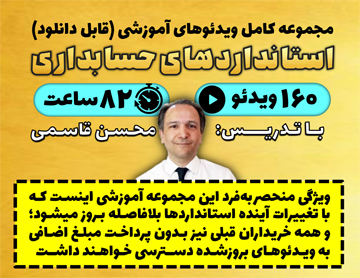واحد تحصیلکننده: واحد تجاری که کنترل واحد تحصیلشده را به دست میآورد. (استاندارد حسابداری 38 ترکیبهای تجاری (مصوب 1398))
پیوست استاندارد: رهنمود بکارگیری
تشخیص واحد تحصیلکننده (بکارگیری بندهای 7 و 8)
ب13. رهنمود مندرج در استاندارد حسابداری 39 (مصوب 1398)، باید برای تشخیص واحد تحصیلكننده، یعنی واحد تجاری كه كنترل واحد تحصیلشده را به دست میآورد، بكار گرفته شود. در صورتی كه تركیب تجاری واقع شده باشد اما بكارگیری رهنمود مندرج در استاندارد حسابداری 39 (مصوب 1398) به روشنی مشخص نكند که كدام یك از واحدهای ترکیبشونده، واحد تحصیلكننده است، باید عوامل مندرج در بندهای ب14 تا ب18، در تعیین واحد تحصیلكننده مدنظر قرار گیرد.
ب14. در یک ترکیب تجاری که اساساً از طریق انتقال نقد یا سایر داراییها یا تحمل بدهی انجام میشود، واحد تحصیلکننده معمولاً واحد تجاری است که نقد یا سایر داراییها را انتقال میدهد یا متحمل بدهی میشود.
ب15. در یک ترکیب تجاری که اساساً از طریق مبادله منافع مالكانه انجام میشود، واحد تحصیلکننده معمولاً واحد تجاری است که منافع مالكانه منتشر میکند. با وجود این، در برخی ترکیبهای تجاری که معمولاً ”تحصیل معکوس“ نامیده میشود، واحد تجاری ناشر، واحد تحصیلشده است. بندهای ب19 تا ب27 ، رهنمودهای مربوط به حسابداری تحصیل معکوس را ارائه میکند. همچنین برای تشخیص واحد تحصیلکننده در ترکیب تجاری انجامشده از طریق مبادله منافع مالکانه، باید سایر واقعیتها و شرایط مربوط مورد توجه قرار گیرد که شامل موارد زیر است:
- الف. حق رأی نسبی در واحد ترکیبشده پس از ترکیب تجاری- واحد تحصیلکننده معمولاً واحد ترکیبشوندهای است که مالکان آن به عنوان یک گروه، بیشترین بخش از حق رأی در واحد ترکیبشده را حفظ یا دریافت میکنند. در تعیین اینكه كدام گروه از مالکان، بیشترین حق رأی را حفظ یا دریافت میکند، واحد تجاری باید وجود هرگونه مورد غیرعادی یا خاص درباره توافقهای حق رأی و اختیار معامله، امتیاز خرید سهام یا اوراق بهادار قابل تبدیل را در نظر بگیرد.
- ب. وجود یک حق رأی اقلیت بزرگ در واحد تركیبشده در صورتی که مالک یا گروه سازمانیافته دیگری از مالكان، حق رأی قابل ملاحظهای نداشته باشند- واحد تحصیلکننده معمولاً واحد تركیبشوندهای است که مالک یا گروه سازمانیافته مالکان آن، دارای بیشترین حق رأی اقلیت در واحد تركیبشده هستند.
- پ. ترکیب ارکان ادارهکننده واحد تركیبشده- واحد تحصیلکننده معمولاً واحد تركیبشوندهای است که مالکان آن، توانایی انتخاب یا انتصاب یا برکناری اكثریت اعضای ارکان ادارهکننده واحد تركیبشده را دارند.
- ت. ترکیب مدیریت ارشد واحد تركیبشده- واحد تحصیلکننده معمولاً واحد تركیبشوندهای است که مدیریت (پیشین) آن، بر مدیریت واحد تركیبشده تسلط دارد.
- ث. شرایط مبادله منافع مالكانه- واحد تحصیلکننده، معمولاً واحد تركیبشوندهای است که مبلغی مازاد بر ارزش منصفانه قبل از ترکیب منافع مالكانه واحد یا واحدهای تركیبشونده دیگر، پرداخت میکند.
ب16. واحد تحصیلکننده معمولاً واحد ترکیبشوندهای است که اندازه نسبی آن (كه برای مثال، بر حسب داراییها، درآمدها یا سود اندازهگیری میشود) به میزان قابل ملاحظهای بیشتر از واحد یا واحدهای تركیبشونده دیگر است.
ب17. در ترکیب تجاری متشکل از بیش از دو واحد تجاری، برای تعیین واحد تحصیلکننده، باید علاوه بر سایر موارد، ملاحظات مربوط به اینكه كدام یك از واحدهای تركیبشونده تركیب را شروع کرده است و اندازة نسبی واحدهای تركیبشونده، مدنظر قرار گیرد.
ب18. واحد تجاری جدید تشکیلشده در نتیجه ترکیب تجاری، لزوماً واحد تحصیلکننده نیست. اگر واحد تجاری جدید برای انجام ترکیب تجاری، منافع مالکانه منتشر كند، یکی از واحدهای ترکیبشونده که قبل از ترکیب تجاری وجود داشته است، باید با بكارگیری رهنمود مندرج در بندهای ب13 تا ب17، به عنوان واحد تحصیلکننده در نظر گرفته شود. در مقابل، واحد تجاری جدید که نقد یا سایر داراییها را به عنوان مابهازا منتقل میکند یا متحمل بدهی میشود، ممکن است واحد تحصیلکننده باشد.
Acquirer: The entity that obtains control of the acquiree - IFRS 3 Business Combinations
Appendix B: Application guidance
Identifying the acquirer (application of paragraphs 6 and 7)–
B13 | The guidance in IFRS 10 Consolidated Financial Statements shall be used to identify the acquirer—the entity that obtains control of the acquiree. If a business combination has occurred but applying the guidance in IFRS 10 does not clearly indicate which of the combining entities is the acquirer, the factors in paragraphs B14–B18 shall be considered in making that determination. |
B14 | In a business combination effected primarily by transferring cash or other assets or by incurring liabilities, the acquirer is usually the entity that transfers the cash or other assets or incurs the liabilities. |
B15 | In a business combination effected primarily by exchanging equity interests, the acquirer is usually the entity that issues its equity interests. However, in some business combinations, commonly called ‘reverse acquisitions’, the issuing entity is the acquiree. Paragraphs B19–B27 provide guidance on accounting for reverse acquisitions. Other pertinent facts and circumstances shall also be considered in identifying the acquirer in a business combination effected by exchanging equity interests, including:
|
B16 | The acquirer is usually the combining entity whose relative size (measured in, for example, assets, revenues or profit) is significantly greater than that of the other combining entity or entities. |
B17 | In a business combination involving more than two entities, determining the acquirer shall include a consideration of, among other things, which of the combining entities initiated the combination, as well as the relative size of the combining entities. |
B18 | A new entity formed to effect a business combination is not necessarily the acquirer. If a new entity is formed to issue equity interests to effect a business combination, one of the combining entities that existed before the business combination shall be identified as the acquirer by applying the guidance in paragraphs B13–B17. In contrast, a new entity that transfers cash or other assets or incurs liabilities as consideration may be the acquirer. |





دیدگاه خود را بنویسید